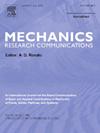利用各向异性弹性理论评价B2金属间化合物< 111 >、< 110 >和< 001 >的滑移方向
IF 2.3
4区 工程技术
Q3 MECHANICS
引用次数: 0
摘要
基于各向异性弹性理论,给出了B2金属间化合物< 111 >{110}、< 110 >{110}和< 001 >{110}滑断体系的断层宽度与特征角、断层能量、断层部分方向和大小的一般表达式。最终,我们发现只有< 111 >{110}形成了明确的偏位,而< 110 >{110}和< 001 >{110}位错仍然是弥散的。此外,对于本文研究的几乎所有B2金属间化合物,断层宽度作为特征角的函数的行为明显偏离各向同性弹性理论。在此基础上,进行了线能计算,讨论了< 111 >{110}、< 110 >{110}和< 001 >{110}滑移体系在B2金属间化合物族中的相对重要性。本文章由计算机程序翻译,如有差异,请以英文原文为准。
Evaluating the 〈111〉, 〈110〉, and 〈001〉 slip directions of the B2 intermetallic by way of anisotropic elasticity theory
Based on anisotropic elasticity theory, general expressions for the fault width as a function of character angle, fault energy, and the direction and magnitude of the partials that form the fault, are developed for the , , and slip systems of the intermetallic. Ultimately, we find that only form well defined partials, while and dislocations remain diffuse. Additionally, for almost all intermetallics studied here, the behavior of the fault widths as a function of character angle deviates significantly from isotropic elasticity theory. Based on these findings, line energy calculations are also performed, and the relative importance of the , , and slip systems within the family of intermetallics are discussed.
求助全文
通过发布文献求助,成功后即可免费获取论文全文。
去求助
来源期刊
CiteScore
4.10
自引率
4.20%
发文量
114
审稿时长
9 months
期刊介绍:
Mechanics Research Communications publishes, as rapidly as possible, peer-reviewed manuscripts of high standards but restricted length. It aims to provide:
• a fast means of communication
• an exchange of ideas among workers in mechanics
• an effective method of bringing new results quickly to the public
• an informal vehicle for the discussion
• of ideas that may still be in the formative stages
The field of Mechanics will be understood to encompass the behavior of continua, fluids, solids, particles and their mixtures. Submissions must contain a strong, novel contribution to the field of mechanics, and ideally should be focused on current issues in the field involving theoretical, experimental and/or applied research, preferably within the broad expertise encompassed by the Board of Associate Editors. Deviations from these areas should be discussed in advance with the Editor-in-Chief.

 求助内容:
求助内容: 应助结果提醒方式:
应助结果提醒方式:


